直接引语和间接引语的语法教学设计
- 格式:doc
- 大小:25.50 KB
- 文档页数:3
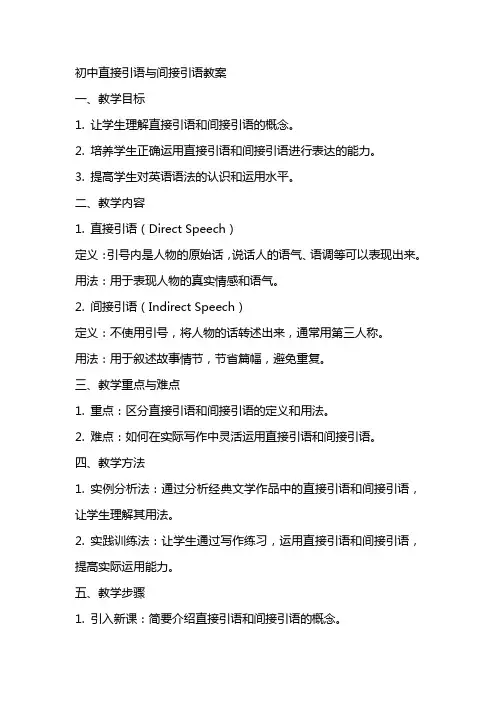
初中直接引语与间接引语教案一、教学目标1. 让学生理解直接引语和间接引语的概念。
2. 培养学生正确运用直接引语和间接引语进行表达的能力。
3. 提高学生对英语语法的认识和运用水平。
二、教学内容1. 直接引语(Direct Speech)定义:引号内是人物的原始话,说话人的语气、语调等可以表现出来。
用法:用于表现人物的真实情感和语气。
2. 间接引语(Indirect Speech)定义:不使用引号,将人物的话转述出来,通常用第三人称。
用法:用于叙述故事情节,节省篇幅,避免重复。
三、教学重点与难点1. 重点:区分直接引语和间接引语的定义和用法。
2. 难点:如何在实际写作中灵活运用直接引语和间接引语。
四、教学方法1. 实例分析法:通过分析经典文学作品中的直接引语和间接引语,让学生理解其用法。
2. 实践训练法:让学生通过写作练习,运用直接引语和间接引语,提高实际运用能力。
五、教学步骤1. 引入新课:简要介绍直接引语和间接引语的概念。
2. 实例分析:分析文学作品中的直接引语和间接引语,让学生感受其用法。
3. 讲解要点:详细讲解直接引语和间接引语的定义和用法。
4. 实践训练:布置写作练习,让学生运用直接引语和间接引语。
5. 课堂讨论:分享学生的写作成果,讨论直接引语和间接引语的运用技巧。
6. 总结反馈:对本节课的内容进行总结,对学生的写作进行评价和反馈。
六、教学活动1. 小组讨论:让学生分组讨论直接引语和间接引语在实际写作中的运用,分享各自的见解和经验。
2. 案例分析:分析更多文学作品中的直接引语和间接引语,引导学生掌握其运用技巧。
七、课堂练习1. 编写短文:让学生运用直接引语和间接引语各写一段短文,描述一个日常生活中的场景。
2. 互评互改:让学生互相交换习作,进行评价和修改,提高写作水平。
八、拓展学习1. 让学生收集运用直接引语和间接引语的优秀作文或文章,进行欣赏和分析。
2. 推荐相关书籍或资源,让学生课后进一步学习和提高。
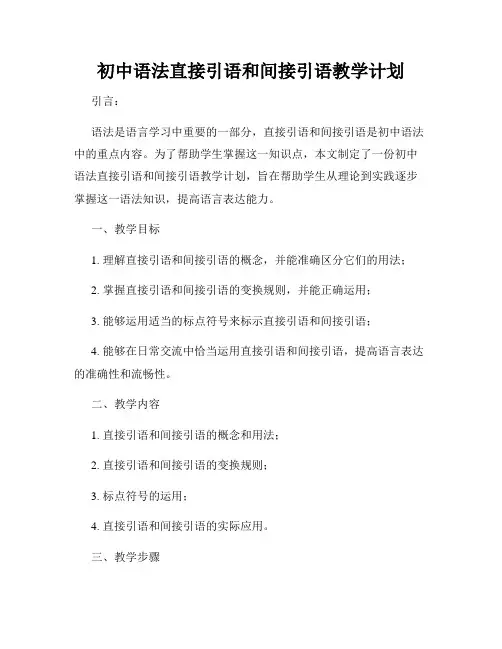
初中语法直接引语和间接引语教学计划引言:语法是语言学习中重要的一部分,直接引语和间接引语是初中语法中的重点内容。
为了帮助学生掌握这一知识点,本文制定了一份初中语法直接引语和间接引语教学计划,旨在帮助学生从理论到实践逐步掌握这一语法知识,提高语言表达能力。
一、教学目标1. 理解直接引语和间接引语的概念,并能准确区分它们的用法;2. 掌握直接引语和间接引语的变换规则,并能正确运用;3. 能够运用适当的标点符号来标示直接引语和间接引语;4. 能够在日常交流中恰当运用直接引语和间接引语,提高语言表达的准确性和流畅性。
二、教学内容1. 直接引语和间接引语的概念和用法;2. 直接引语和间接引语的变换规则;3. 标点符号的运用;4. 直接引语和间接引语的实际应用。
三、教学步骤第一阶段:理论讲解1. 引导学生了解直接引语和间接引语的概念和用法,与学生一起分析直接引语和间接引语在实际交流中的运用场景,例如对话、报道、叙述等;2. 呈现并解释直接引语和间接引语的变换规则,与学生一起总结并掌握这些规则;3. 通过实例演示,帮助学生掌握标点符号的运用规则,特别是引号和句号的使用。
第二阶段:练习巩固1. 分发练习题,让学生针对直接引语和间接引语进行变换练习;2. 组织小组活动,要求学生在日常场景中模拟对话,并在对话中使用直接引语和间接引语;3. 进行语法竞赛,以小组为单位进行问答,检验学生对直接引语和间接引语的掌握程度。
第三阶段:实践运用1. 给予学生一篇文章,要求他们读文章并找出其中的直接引语和间接引语;2. 鼓励学生以小组为单位,互相展示并分析找到的直接引语和间接引语的用法,让学生在分析中加深对语法知识的理解;3. 让学生根据实际情境,编写对话或文章,并运用直接引语和间接引语。
四、评价方法1. 在练习巩固环节中,教师对学生的练习作业进行检查,并给予及时反馈;2. 在实践运用环节中,教师根据学生的表现和作业,综合评价学生对直接引语和间接引语的掌握程度。
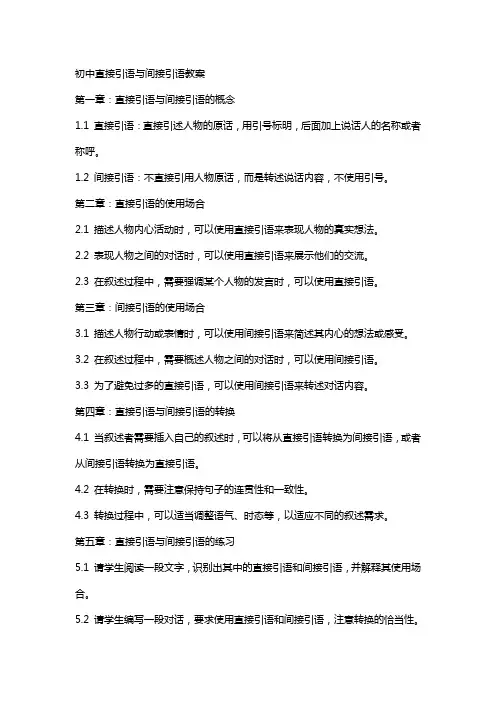
初中直接引语与间接引语教案第一章:直接引语与间接引语的概念1.1 直接引语:直接引述人物的原话,用引号标明,后面加上说话人的名称或者称呼。
1.2 间接引语:不直接引用人物原话,而是转述说话内容,不使用引号。
第二章:直接引语的使用场合2.1 描述人物内心活动时,可以使用直接引语来表现人物的真实想法。
2.2 表现人物之间的对话时,可以使用直接引语来展示他们的交流。
2.3 在叙述过程中,需要强调某个人物的发言时,可以使用直接引语。
第三章:间接引语的使用场合3.1 描述人物行动或表情时,可以使用间接引语来简述其内心的想法或感受。
3.2 在叙述过程中,需要概述人物之间的对话时,可以使用间接引语。
3.3 为了避免过多的直接引语,可以使用间接引语来转述对话内容。
第四章:直接引语与间接引语的转换4.1 当叙述者需要插入自己的叙述时,可以将从直接引语转换为间接引语,或者从间接引语转换为直接引语。
4.2 在转换时,需要注意保持句子的连贯性和一致性。
4.3 转换过程中,可以适当调整语气、时态等,以适应不同的叙述需求。
第五章:直接引语与间接引语的练习5.1 请学生阅读一段文字,识别出其中的直接引语和间接引语,并解释其使用场合。
5.2 请学生编写一段对话,要求使用直接引语和间接引语,注意转换的恰当性。
5.3 请学生对已有的文章进行修改,将直接引语转换为间接引语,或者将间接引语转换为直接引语,以提高文章的表现力。
第六章:直接引语与间接引语的语法特点6.1 直接引语的语法特点:引号内的文字要尽量保持原话的风格,包括语气、感叹词等;引号内的文字前通常会有引导词,如“他说”、“她问”等;引号外的文字要使用说话人的视角来描述。
6.2 间接引语的语法特点:转述的文字需要使用第三人称或第一人称;无需使用引号,但可以在句子开头使用引导词,如“他说”、“她想”等;需要将原话中的具体指代词(如“我”、“你”、“他”等)转换为代词或名词。
第七章:直接引语与间接引语的写作技巧7.1 直接引语的写作技巧:通过引号内的原话展现人物的语言风格和个性;利用引号内的语气、感叹词等表达人物的强烈情感;在引号外添加说话人的动作、表情等描写,以丰富画面感。
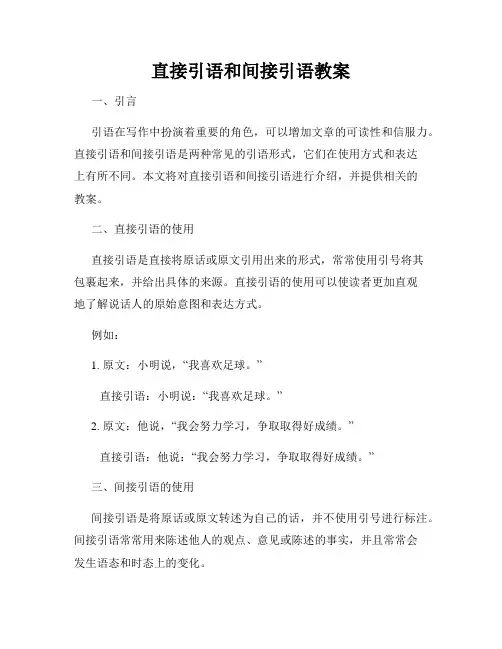
直接引语和间接引语教案一、引言引语在写作中扮演着重要的角色,可以增加文章的可读性和信服力。
直接引语和间接引语是两种常见的引语形式,它们在使用方式和表达上有所不同。
本文将对直接引语和间接引语进行介绍,并提供相关的教案。
二、直接引语的使用直接引语是直接将原话或原文引用出来的形式,常常使用引号将其包裹起来,并给出具体的来源。
直接引语的使用可以使读者更加直观地了解说话人的原始意图和表达方式。
例如:1. 原文:小明说,“我喜欢足球。
”直接引语:小明说:“我喜欢足球。
”2. 原文:他说,“我会努力学习,争取取得好成绩。
”直接引语:他说:“我会努力学习,争取取得好成绩。
”三、间接引语的使用间接引语是将原话或原文转述为自己的话,并不使用引号进行标注。
间接引语常常用来陈述他人的观点、意见或陈述的事实,并且常常会发生语态和时态上的变化。
例如:1. 原文:小明说,“我喜欢足球。
”间接引语:小明说他喜欢足球。
2. 原文:他说,“我会努力学习,争取取得好成绩。
”间接引语:他说他会努力学习,争取取得好成绩。
四、以下是一份针对直接引语和间接引语的教案,旨在帮助学生正确理解和运用这两种引语形式。
教学目标:1. 学会辨认直接引语和间接引语;2. 掌握使用直接引语和间接引语的正确形式和用法;3. 能够转述直接引语为间接引语。
教学内容:1. 教师向学生解释直接引语和间接引语的概念,并给出具体的例子;2. 学生进行语法练习,辨认句子中的直接引语和间接引语;3. 学生进行转述练习,将给定的直接引语转变为间接引语;4. 教师对学生的答案进行讲解和评价。
教学步骤:1. 教师简要介绍直接引语和间接引语的概念,并说明它们的区别;2. 教师给出一些例子,让学生观察并判断是直接引语还是间接引语;3. 学生进行语法练习,辨认句子中的直接引语和间接引语;4. 学生进行转述练习,将给定的直接引语转变为间接引语;5. 学生讨论和对比各自的答案,并进行纠正;6. 教师对学生的答案进行讲解和评价,强调正确的用法和注意事项。
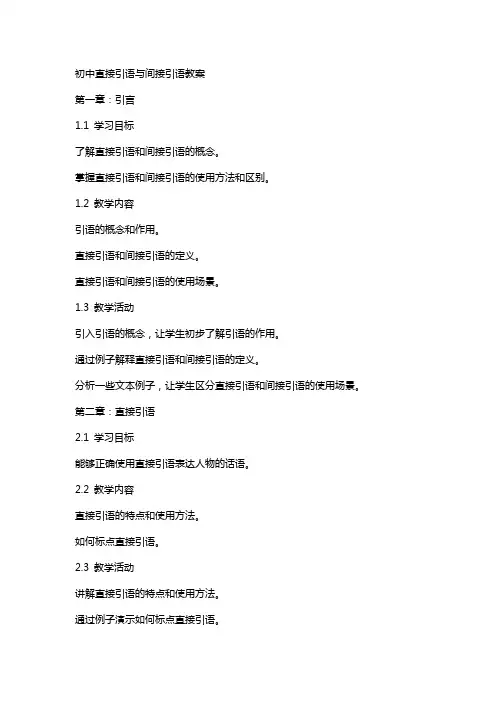
初中直接引语与间接引语教案第一章:引言1.1 学习目标了解直接引语和间接引语的概念。
掌握直接引语和间接引语的使用方法和区别。
1.2 教学内容引语的概念和作用。
直接引语和间接引语的定义。
直接引语和间接引语的使用场景。
1.3 教学活动引入引语的概念,让学生初步了解引语的作用。
通过例子解释直接引语和间接引语的定义。
分析一些文本例子,让学生区分直接引语和间接引语的使用场景。
第二章:直接引语2.1 学习目标能够正确使用直接引语表达人物的话语。
2.2 教学内容直接引语的特点和使用方法。
如何标点直接引语。
2.3 教学活动讲解直接引语的特点和使用方法。
通过例子演示如何标点直接引语。
让学生进行练习,用直接引语表达人物的话语。
第三章:间接引语3.1 学习目标能够正确使用间接引语表达人物的话语。
3.2 教学内容间接引语的特点和使用方法。
如何标点间接引语。
3.3 教学活动讲解间接引语的特点和使用方法。
通过例子演示如何标点间接引语。
让学生进行练习,用间接引语表达人物的话语。
第四章:直接引语与间接引语的转换4.1 学习目标能够理解和掌握直接引语和间接引语之间的转换。
4.2 教学内容直接引语和间接引语之间的转换方法。
转换时需要注意的问题。
4.3 教学活动讲解直接引语和间接引语之间的转换方法。
通过例子演示如何进行转换。
分析一些文本例子,让学生理解转换时需要注意的问题。
第五章:综合练习5.1 学习目标能够综合运用直接引语和间接引语进行写作。
5.2 教学内容综合运用直接引语和间接引语的技巧。
5.3 教学活动讲解综合运用直接引语和间接引语的技巧。
提供一些写作任务,让学生进行练习。
互相交流并给予反馈,提高写作水平。
第六章:直接引语与间接引语的运用场景6.1 学习目标能够根据不同的写作场景选择合适的直接引语或间接引语。
6.2 教学内容直接引语和间接引语在不同场景下的运用。
不同引语方式对写作风格和效果的影响。
6.3 教学活动分析不同场景下直接引语和间接引语的运用例子。
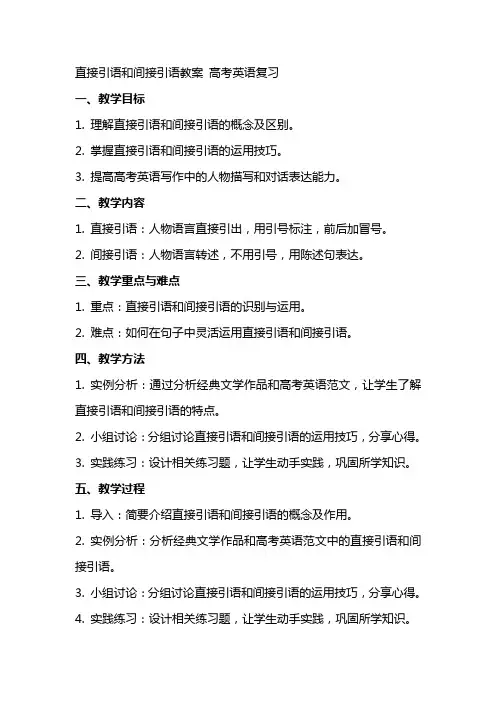
直接引语和间接引语教案高考英语复习一、教学目标1. 理解直接引语和间接引语的概念及区别。
2. 掌握直接引语和间接引语的运用技巧。
3. 提高高考英语写作中的人物描写和对话表达能力。
二、教学内容1. 直接引语:人物语言直接引出,用引号标注,前后加冒号。
2. 间接引语:人物语言转述,不用引号,用陈述句表达。
三、教学重点与难点1. 重点:直接引语和间接引语的识别与运用。
2. 难点:如何在句子中灵活运用直接引语和间接引语。
四、教学方法1. 实例分析:通过分析经典文学作品和高考英语范文,让学生了解直接引语和间接引语的特点。
2. 小组讨论:分组讨论直接引语和间接引语的运用技巧,分享心得。
3. 实践练习:设计相关练习题,让学生动手实践,巩固所学知识。
五、教学过程1. 导入:简要介绍直接引语和间接引语的概念及作用。
2. 实例分析:分析经典文学作品和高考英语范文中的直接引语和间接引语。
3. 小组讨论:分组讨论直接引语和间接引语的运用技巧,分享心得。
4. 实践练习:设计相关练习题,让学生动手实践,巩固所学知识。
5. 总结:总结直接引语和间接引语的运用要点,提醒学生在写作中的注意事项。
教学反思:六、教学拓展1. 对比分析:让学生对比直接引语和间接引语在表达上的优缺点,了解在不同情境下如何选择使用。
2. 引语变异:介绍引语的其它变异形式,如自由间接引语、混合引语等,让学生拓展视野。
七、课堂互动1. 问答环节:针对直接引语和间接引语的相关问题,进行问答互动,检验学生对知识点的掌握。
2. 角色扮演:分组进行角色扮演,模拟真实场景,运用直接引语和间接引语进行对话。
八、课后作业1. 选取一篇范文,分析其中的直接引语和间接引语,总结其运用技巧。
九、教学评价1. 课堂表现:观察学生在课堂上的参与程度、提问回答等情况,评价学生的学习态度和效果。
2. 练习成果:评估学生在练习中的表现,检查他们对直接引语和间接引语的运用能力。
3. 课后作业:审阅学生的课后作业,了解他们在实际写作中运用直接引语和间接引语的情况。
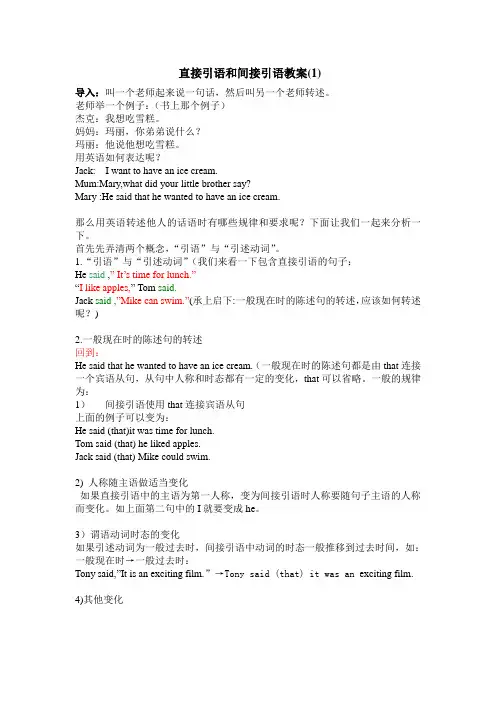
直接引语和间接引语教案(1)导入:叫一个老师起来说一句话,然后叫另一个老师转述。
老师举一个例子:(书上那个例子)杰克:我想吃雪糕。
妈妈:玛丽,你弟弟说什么?玛丽:他说他想吃雪糕。
用英语如何表达呢?Jack: I want to have an ice cream.Mum:Mary,what did your little brother say?Mary :He said that he wanted to have an ice cream.那么用英语转述他人的话语时有哪些规律和要求呢?下面让我们一起来分析一下。
首先先弄清两个概念,“引语”与“引述动词”。
1.“引语”与“引述动词”(我们来看一下包含直接引语的句子:He said ,” It’s time for lunch.”“I like apples,” Tom said.Jack said ,”Mike can swim.”(承上启下:一般现在时的陈述句的转述,应该如何转述呢?)2.一般现在时的陈述句的转述回到:He said that he wanted to have an ice cream.(一般现在时的陈述句都是由that连接一个宾语从句,从句中人称和时态都有一定的变化,that可以省略。
一般的规律为:1)间接引语使用that连接宾语从句上面的例子可以变为:He said (that)it was time for lunch.Tom said (that) he liked apples.Jack said (that) Mike could swim.2) 人称随主语做适当变化如果直接引语中的主语为第一人称,变为间接引语时人称要随句子主语的人称而变化。
如上面第二句中的I就要变成he。
3)谓语动词时态的变化如果引述动词为一般过去时,间接引语中动词的时态一般推移到过去时间,如:一般现在时→一般过去时:Tony said,”It is an exciting film.”→Tony said (that) it was an exciting film.4)其他变化指示代词时间状语地点状语动词Thi s→that now→then here→there come→goThese→those today→that day bring→takeTonight→that nightHe said ,”I’m here.”→He said that he was there.Jack said ,”There is a good film on tonight,”→Jack said that there was a good film on tonight.直接引语和间接引语(2)祈使句的转述如果是转述他人的请求或命令:首先我们来看几个例子:He said to the children,”Be quiet.”→He told the children to be quiet. He said to Betty,”Stop,”→He asked Betty to stop.从这两例句我们可以看出祈使句变成间接引语的方式:tell sb. to do sth.或ask sb.to do sth .1)如果直接引语中含有please,间接引语中的谓语动词一般用ask等表示要求的单词。
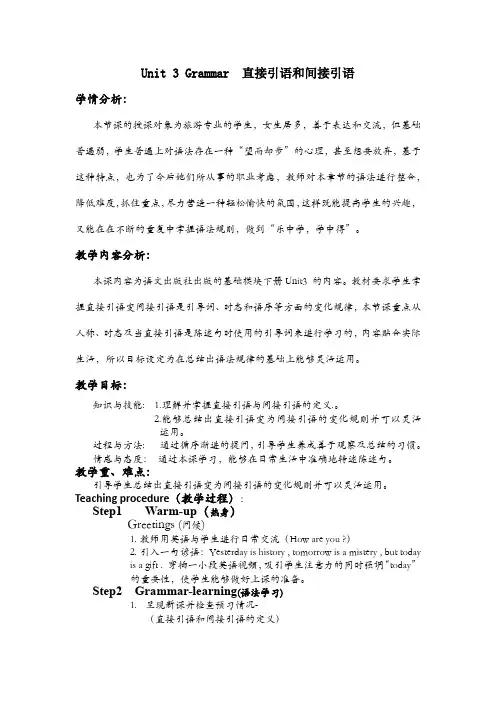
Unit 3 Grammar 直接引语和间接引语学情分析:本节课的授课对象为旅游专业的学生,女生居多,善于表达和交流,但基础普遍弱,学生普遍上对语法存在一种“望而却步”的心理,甚至想要放弃,基于这种特点,也为了今后她们所从事的职业考虑,教师对本章节的语法进行整合,降低难度,抓住重点,尽力营造一种轻松愉快的氛围,这样既能提高学生的兴趣,又能在在不断的重复中掌握语法规则,做到“乐中学,学中得”。
教学内容分析:本课内容为语文出版社出版的基础模块下册Unit3 的内容。
教材要求学生掌握直接引语变间接引语是引导词、时态和语序等方面的变化规律,本节课重点从人称、时态及当直接引语是陈述句时使用的引导词来进行学习的,内容贴合实际生活,所以目标设定为在总结出语法规律的基础上能够灵活运用。
教学目标:知识与技能: 1.理解并掌握直接引语与间接引语的定义.。
2.能够总结出直接引语变为间接引语的变化规则并可以灵活运用。
过程与方法: 通过循序渐进的提问,引导学生养成善于观察及总结的习惯。
情感与态度:通过本课学习,能够在日常生活中准确地转述陈述句。
教学重、难点:引导学生总结出直接引语变为间接引语的变化规则并可以灵活运用。
Teaching procedure(教学过程):Step1 Warm-up(热身)Greetings (问候)1.教师用英语与学生进行日常交流(How are you ?)2.引入一句谚语:Yesterday is history , tomorrow is a mistery , but todayis a gift . 穿插一小段英语视频,吸引学生注意力的同时强调“today”的重要性,使学生能够做好上课的准备。
Step2 Grammar-learning(语法学习)1.呈现新课并检查预习情况-(直接引语和间接引语的定义)2.找不同(直接引语变为间接引语时,哪3.些地方发生了变化?)Mr Black said ,“I like playing football .”eg.Mr Black said that he liked playing football .He said , “I am reading the book.”He said that he was reading the book.”She said , “I will do it after class .”She said that she would do it after class .He said , “I came to help you .”He said that he had come to help you .3. 学生思考、教师引导,共同总结出变化规则:(口诀:一随主,二随宾,三不变)( 倒退一个时态)that(当直接引语是陈述句时)Step3 Practice(练一练)将下列的直接引语变为间接引语1. “I never eat meat .”he said .2. “I am having supper ,”he said .3. The girl said to me , “My mother will be very happy to see you . ”4.He said , “I forgot to turn off the lights .”几名学生演板,其他同学核对纠正,老师对错误点进行强调。
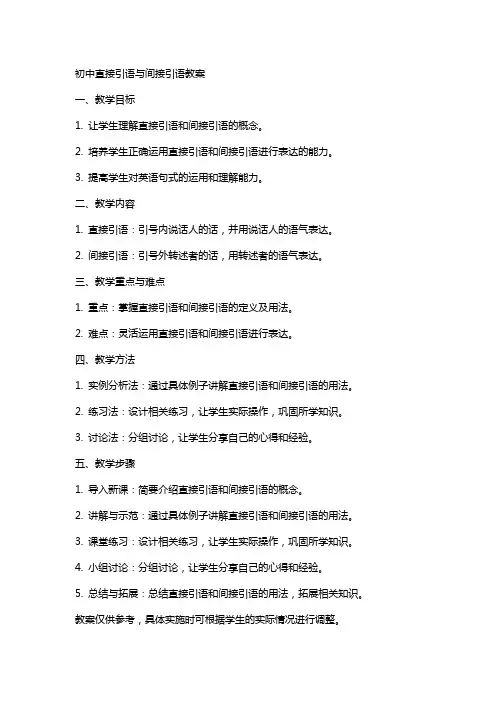
初中直接引语与间接引语教案一、教学目标1. 让学生理解直接引语和间接引语的概念。
2. 培养学生正确运用直接引语和间接引语进行表达的能力。
3. 提高学生对英语句式的运用和理解能力。
二、教学内容1. 直接引语:引号内说话人的话,并用说话人的语气表达。
2. 间接引语:引号外转述者的话,用转述者的语气表达。
三、教学重点与难点1. 重点:掌握直接引语和间接引语的定义及用法。
2. 难点:灵活运用直接引语和间接引语进行表达。
四、教学方法1. 实例分析法:通过具体例子讲解直接引语和间接引语的用法。
2. 练习法:设计相关练习,让学生实际操作,巩固所学知识。
3. 讨论法:分组讨论,让学生分享自己的心得和经验。
五、教学步骤1. 导入新课:简要介绍直接引语和间接引语的概念。
2. 讲解与示范:通过具体例子讲解直接引语和间接引语的用法。
3. 课堂练习:设计相关练习,让学生实际操作,巩固所学知识。
4. 小组讨论:分组讨论,让学生分享自己的心得和经验。
5. 总结与拓展:总结直接引语和间接引语的用法,拓展相关知识。
教案仅供参考,具体实施时可根据学生的实际情况进行调整。
六、教学活动1. 设计一个角色扮演活动,让学生模拟不同人物之间的对话,其中一部分对话使用直接引语,另一部分使用间接引语。
2. 学生分组进行表演,鼓励他们注意引语的使用和语气的表现。
3. 表演后,组织学生进行互评和自我评价,讨论哪种引语使用得更自然、更有效。
七、案例分析1. 提供一系列句子,其中有些句子已经使用了直接引语或间接引语,有些则需要学生自己判断和修改。
2. 让学生分析每个句子的语境,判断是否需要使用引语,以及使用哪种引语更合适。
3. 讨论引语对句子意思和语气的影响,以及如何在不同情境下选择合适的引语形式。
八、写作练习1. 布置一个写作任务,要求学生写一段对话或叙述,其中必须包含直接引语和间接引语。
2. 鼓励学生在写作中注意引语的正确使用,以及人物语气和表情的描写。
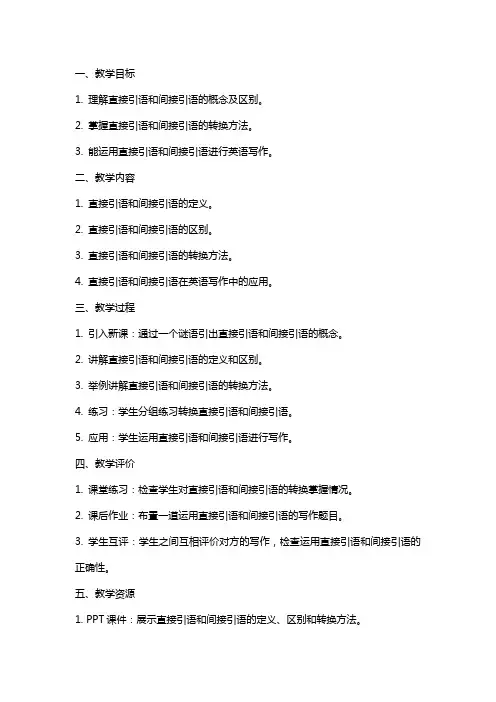
一、教学目标1. 理解直接引语和间接引语的概念及区别。
2. 掌握直接引语和间接引语的转换方法。
3. 能运用直接引语和间接引语进行英语写作。
二、教学内容1. 直接引语和间接引语的定义。
2. 直接引语和间接引语的区别。
3. 直接引语和间接引语的转换方法。
4. 直接引语和间接引语在英语写作中的应用。
三、教学过程1. 引入新课:通过一个谜语引出直接引语和间接引语的概念。
2. 讲解直接引语和间接引语的定义和区别。
3. 举例讲解直接引语和间接引语的转换方法。
4. 练习:学生分组练习转换直接引语和间接引语。
5. 应用:学生运用直接引语和间接引语进行写作。
四、教学评价1. 课堂练习:检查学生对直接引语和间接引语的转换掌握情况。
2. 课后作业:布置一道运用直接引语和间接引语的写作题目。
3. 学生互评:学生之间互相评价对方的写作,检查运用直接引语和间接引语的正确性。
五、教学资源1. PPT课件:展示直接引语和间接引语的定义、区别和转换方法。
2. 练习材料:提供一些直接引语和间接引语的例子,供学生练习转换。
3. 写作纸张:供学生进行写作练习。
六、教学拓展1. 引导学生探讨直接引语和间接引语在实际交流中的运用场景。
2. 分析直接引语和间接引语在文学作品中的作用。
3. 引导学生思考直接引语和间接引语在学术写作中的应用。
七、教学活动1. 小组讨论:学生分组讨论直接引语和间接引语在实际交流中的运用。
2. 案例分析:分析一篇文学作品中的直接引语和间接引语运用。
3. 学术写作:学生尝试在学术写作中运用直接引语和间接引语。
八、教学反思1. 教师反思本节课的教学目标是否达成,教学方法是否合适。
2. 学生反思自己在学习直接引语和间接引语过程中的收获和不足。
九、教学延伸1. 布置课后阅读任务,让学生进一步了解直接引语和间接引语在英语文学作品中的应用。
2. 邀请英语写作专家进行讲座,分享直接引语和间接引语在写作中的技巧。
十、教学总结1. 总结本节课所学内容,强调直接引语和间接引语的重要性和应用价值。
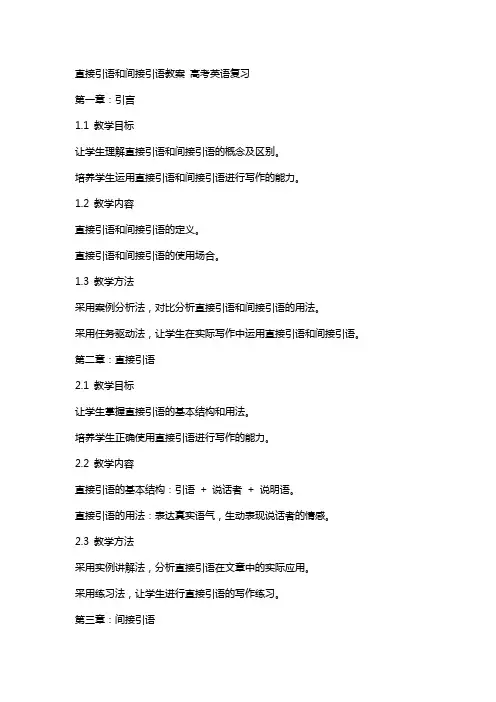
直接引语和间接引语教案高考英语复习第一章:引言1.1 教学目标让学生理解直接引语和间接引语的概念及区别。
培养学生运用直接引语和间接引语进行写作的能力。
1.2 教学内容直接引语和间接引语的定义。
直接引语和间接引语的使用场合。
1.3 教学方法采用案例分析法,对比分析直接引语和间接引语的用法。
采用任务驱动法,让学生在实际写作中运用直接引语和间接引语。
第二章:直接引语2.1 教学目标让学生掌握直接引语的基本结构和用法。
培养学生正确使用直接引语进行写作的能力。
2.2 教学内容直接引语的基本结构:引语+ 说话者+ 说明语。
直接引语的用法:表达真实语气,生动表现说话者的情感。
2.3 教学方法采用实例讲解法,分析直接引语在文章中的实际应用。
采用练习法,让学生进行直接引语的写作练习。
第三章:间接引语3.1 教学目标让学生掌握间接引语的基本结构和用法。
培养学生正确使用间接引语进行写作的能力。
3.2 教学内容间接引语的基本结构:引语+ 说明语。
间接引语的用法:表达客观语气,简化叙述。
3.3 教学方法采用实例讲解法,分析间接引语在文章中的实际应用。
采用练习法,让学生进行间接引语的写作练习。
第四章:直接引语和间接引语的转换4.1 教学目标让学生理解直接引语和间接引语的转换规则。
培养学生灵活运用直接引语和间接引语进行写作的能力。
4.2 教学内容直接引语和间接引语的转换规则。
转换实例分析。
4.3 教学方法采用案例分析法,对比分析直接引语和间接引语的转换。
采用练习法,让学生进行直接引语和间接引语的转换练习。
第五章:直接引语和间接引语在实际写作中的应用5.1 教学目标让学生掌握直接引语和间接引语在实际写作中的应用技巧。
培养学生灵活运用直接引语和间接引语进行写作的能力。
5.2 教学内容直接引语和间接引语在写作中的优势和局限。
实际应用实例分析。
5.3 教学方法采用实例讲解法,分析直接引语和间接引语在文章中的实际应用。
采用练习法,让学生进行直接引语和间接引语的写作练习。
初中直接引语与间接引语教案一、教学目标1. 让学生理解直接引语和间接引语的概念及区别。
2. 培养学生正确运用直接引语和间接引语进行表达的能力。
3. 提高学生对英语句型的掌握,丰富写作技巧。
二、教学内容1. 直接引语:用引号将说话人的原话直接引用,并使用说话人的说话方式来表达。
2. 间接引语:不使用引号,将说话人的话转述出来,用陈述句或疑问句表达。
三、教学重点与难点1. 重点:掌握直接引语和间接引语的运用方法和特点。
2. 难点:如何正确处理直接引语和间接引语中的时态、语态等问题。
四、教学方法1. 实例分析法:通过分析典型例句,让学生理解并掌握直接引语和间接引语的特点。
2. 实践演练法:设计相关练习,让学生在实际操作中学会运用直接引语和间接引语。
3. 小组讨论法:分组讨论,共同探讨直接引语和间接引语的运用技巧。
五、教学步骤1. 引入新课:通过一个简单的对话,引导学生关注直接引语和间接引语。
2. 讲解直接引语和间接引语的概念及区别:直接引语和间接引语的定义,两者的区别。
3. 分析实例:分析典型例句,让学生理解直接引语和间接引语的特点。
4. 实践演练:设计相关练习,让学生运用直接引语和间接引语进行表达。
5. 小组讨论:分组讨论,共同探讨直接引语和间接引语的运用技巧。
6. 总结与反馈:对本节课的内容进行总结,对学生进行评价和反馈。
教案设计仅供参考,具体实施时可根据学生的实际情况进行调整。
六、教学拓展1. 引导学生关注直接引语和间接引语在实际生活中的应用,提高学生对语言的敏感度。
2. 举例分析直接引语和间接引语在文学作品中的运用,欣赏其表达效果。
七、课堂小结1. 直接引语和间接引语的概念及区别。
2. 直接引语和间接引语的运用方法和特点。
3. 直接引语和间接引语在实际应用中的注意事项。
八、课后作业1. 复习直接引语和间接引语的知识点。
2. 完成课后练习,运用直接引语和间接引语进行表达。
3. 收集生活中的直接引语和间接引语实例,进行分析。
一. 教学内容:语法——直接引语和间接引语[具体教学过程]观察以下句子中直接引语和间接引语的转换,试着归纳总结其变化规律。
1. He said, “ I’m going to Beijing.〞→He said that he was going to Beijing.2. He asked, “ Are you a teacher?〞→He asked me if / whether I was a teacher.3. She said, “ What are you doing?〞→She asked me what I was doing.4. “What a lovely girl (she is)!〞they said.→They said that she was a lovely girl.5. “ Follow me,〞she said to me.→She told me to follow her.6. “Can you lend me a hand?〞he asked.→He asked me to lend him a hand.7. He said, “Let’s stay here till tomorrow.〞→He suggested that we should stay there till the next day.* 直接引述别人的话,叫“直接引语〞。
用自己的话转述别人的话,叫“间接引语〞。
间接引语在多数情况下构成宾语从句。
直接引语一般前后要加引号,间接引语不用引号。
1. 陈述句直接引语如果是陈述句,变为间接引语时,用连词引导〔that 在口语中常省略〕,从句中的人称、时态、指示代词、时间状语、地点状语等要作相应的变化。
在这一方面,汉语和英语有很多相似之处,因此在做直接引语和间接引语转换练习时,要特别注意句子的意义。
〔1〕人称的变化He said, “ I’m going to Beijing.〞他说:“我要去。
初中直接引语与间接引语教案一、教学目标1. 让学生理解直接引语和间接引语的概念及其区别。
2. 培养学生运用直接引语和间接引语进行写作的能力。
3. 提高学生对英语语法的认识和运用水平。
二、教学内容1. 直接引语(Direct Speech)定义:引号内的第一人称说话,表示实际所说的话。
用法:用于表达真实对话或内心独白。
2. 间接引语(Indirect Speech)定义:没有引号,通过第三方转述说话内容。
用法:用于叙述事件、传达信息或展示人物思想感情。
三、教学重点与难点1. 重点:直接引语和间接引语的定义及其在句子中的运用。
2. 难点:如何正确转换直接引语和间接引语,以及在写作中灵活运用。
四、教学方法1. 实例分析:通过分析经典文学作品和日常对话,让学生了解直接引语和间接引语的特点。
2. 小组讨论:分组讨论直接引语和间接引语的用法,提高学生的参与度和理解力。
3. 写作练习:布置相关写作任务,让学生在实际操作中掌握两种引语的运用。
五、教学步骤1. 引入新课:简要介绍直接引语和间接引语的概念,激发学生兴趣。
2. 讲解与示范:讲解直接引语和间接引语的特点及用法,举例示范。
3. 小组讨论:让学生分组讨论直接引语和间接引语的差别,分享心得。
4. 写作练习:布置练习题,让学生运用直接引语和间接引语进行写作。
5. 作品展示与点评:挑选学生作品进行展示,互相评价,教师点评并指导改进。
教学反思:本节课通过实例分析和小组讨论,使学生对直接引语和间接引语有了更深入的了解。
在写作练习环节,学生能够灵活运用两种引语,提高了写作水平。
但部分学生在实际操作中仍存在一定的困难,需要在课后加强练习和辅导。
六、教学拓展1. 引导学生关注直接引语和间接引语在实际生活中的应用,提高学生的语言感知能力。
2. 介绍其他引语形式(如自由引语、混合引语等),扩大学生的知识面。
七、课后作业2. 运用直接引语和间接引语各写一段对话或叙述。
八、教学评价1. 课堂参与度:观察学生在课堂讨论、提问等方面的积极性。
《直接引语和间接引语》教学案例教学过程I,GreetingsII,Lead-inThe teacher will tell students a joke about direct speech and indirect speech, that is:It was the first day for Xiaoming to go to school. After school, Father asked Xiaoming what he learned that day. Xiaoming said:“I learned she,you and I”. Then Father asked how the teacher explained that.“She is your fellow student.” Xiaoming answered happily, pointing to her mother.“you are my pupil.”“I am your teacher.”The father became angry,and said :“she is your mother”“ you are my son”“I am your father.”The next day ,in class,the boy went to the teacher and told the techer his puzzle, and he said to the teachetr:“She is your mother.” Pointing to his deskmate.“you are my son.”“I am your father.”同时我把这三组句子用不同颜色的笔写在黑板上笑话讲完,同学们哄堂大笑。
我适时提出了这样的问题,what mistakes did Xiaoming made?这时同学们开始积极地思考并开始尝试回答问题。
直接引语和间接引语的语法教学设计The final revision was on November 23, 2020?直接引语和间接引语的语法教学设计?徐登芳积石中学一、教学内容Discovering useful structures二、教学目标使学生掌握直接引语变间接引语的方法教师讲解:直接引语变间接引语?A陈述句的间接引语?直接引语是陈述句,变为间接引语时,在多数情况下都构成一个that引导的宾语从句,引述动词通常是say, tell等。
与此同时,间接引语中的人称、时态和其他方面也要相应有所变化。
The foreigner aid to me, I like Beijing very much.那老外告诉我:我很喜欢北京。
→ The foreigner told me that he she liked Beijing very much. 那老外告诉我说他(她)很喜欢北京。
She said,We are very fond of sports. 她说:我们都喜欢体育运动。
→ She said that they were very fond of sports. 她说他(她)们都喜欢体运动。
I'll go over the grammar lesson once again,he said. 他说:我将把语法课再复习一遍。
→ He said he would go over the grammar lesson once again. 他说他将要把语法课再复习一遍。
(that可省略)?B.疑问句的间接引语?1.一般疑问句和反意疑问句一般疑问句改为间接引语时,要用陈述语序,并要加连词if 或 whether,其主句动词常用ask, wonder, wantto know, didn't know等。
句末不用问号。
My teacher asked me, Do you like American country music 我老师问我:你喜欢美国乡村音乐吗→ My teacher asked me ifwhether I liked American country music. 我老师问我是否喜欢美国乡村音乐。
直接引语和间接引语教案直接引语和间接引语教案一、教学目标:1.了解直接引语和间接引语的定义和区别;2.学会如何使用直接引语和间接引语;3.能够转换句子的直接和间接引语形式。
二、教学重点:掌握直接引语和间接引语的使用方法。
三、教学难点:如何转换句子的直接和间接引语形式。
四、教学方式:听、说、读、写相结合的教学方法。
五、教学准备:黑板、彩色粉笔、英语课本。
六、教学过程第一步:导入1.教师自我介绍并问候学生;2.发放课本,让学生找到本节课所要学习的内容。
第二步:展示1.让学生观看直接引语和间接引语的例子,并解释其定义和区别。
例1:直接引语── “I like playing football.”(我喜欢踢足球。
)例2:间接引语── He said that he liked playing football. (他说他喜欢踢足球。
)2.让学生观看其他例子,并寻找直接引语和间接引语之间的区别。
第三步:练习1.让学生完成小组活动,尝试将一些句子从直接引语转换为间接引语,并从间接引语转换为直接引语。
例1:直接引语── “I like music.”(我喜欢音乐。
)间接引语── She said that she liked music. (她说她喜欢音乐。
)例2:直接引语── “I’ll come to the party.” (我会来参加聚会。
)间接引语── She said she would come to the party. (她说她会来参加聚会。
)2.将学生分成两组,给每组一些直接引语的句子。
每个小组应选择两个句子,并将其转换为间接引语形式。
然后,组长应向全班展示他们转换后的句子,其他同学应判断句子是否正确。
第四步:讲解1.解释转换句子的步骤:1)将直接引语的引号去掉。
2)如果引语是陈述句,将动词said,told,asked,或者其他引用动词放到引语前面。
3)如果引语是问句,将动词said,told,asked,或者其他引用动词放到引语前面,并用一个问号代替句号。
Direct speech and indirect speech
授课时间:20120925
授课地点:高一(5)班
授课人:王行盛
一、Teaching contents: Discovering useful structures
二、Teaching goals: make students to master the usages of direct speech and ind
irect speech
三、Teaching procedures
Step 1: Ask students to look for the sentences of direct speech and indirect speech in the reading text on page 2.
Step 2:
Teacher explain in detail:direct speech and indirect speech
A.陈述句的间接引语
直接引语是陈述句,变为间接引语时,在多数情况下都构成一个that引导的宾语从句,引述动词通常是say, tell等。
与此同时,间接引语中的人称、时态和其他方面也要相应有所变化。
The foreigner said to me, “I like Beijing very much.”那老外告诉我:我很喜欢北京。
→ The foreigner told me that he she liked Beijing very much. 那老外告诉我说他(她)很喜欢北京。
She said, “We are very fond of sports.”她说:我们都喜欢体育运动。
→ She said that they were very fond of sports. 她说他(她)们都喜欢体运动。
“I'll go over the grammar lesson once again,” he said. 他说:我将把语法课再复习一遍。
→ He said he would go over the grammar lesson once again. 他说他将要把语法课再复习一遍。
(that可省略)
B.疑问句的间接引语
1.一般疑问句和反意疑问句
一般疑问句改为间接引语时,要用陈述语序,并要加连词if 或 whether,其主句动词常用ask, wonder, want to know, didn't know等。
句末不用问号。
My teacher asked me, “Do you like American country music ”我老师问我:你喜欢美国乡村音乐吗?
→ My teacher asked me if/whether I liked American country music. 我老师问我是否喜欢美国乡村音乐。
“You haven't been to Beijing, have you ?”asked he. 他问:你没去过北,是吗?
→ He asked me if/whether I had been to Beijing. 他问我是否去过北京。
2.否定的一般疑问句和选择问句
如果直接引语为否定的一般问句或选择疑问句时,用whether or 连接。
She said, “Don't you know my telephone number”她说:你难道不知道我的电话号码吗?
→ She asked me whether I knew her telephone number or not. 她问我是知道她的电话号码。
“Do you like this one or that one?” Tom asked. 汤姆问:你是喜欢这个还是那个?
→ Tom asked me whether I liked this one or that one. 汤姆问我是喜欢这个还是那个。
3.特殊疑问句
间接引语为特殊疑问句时,间接引语前仍然用特殊疑问词作为连词引导宾语从句,注意从句必须用陈述语序,主句谓语动词常用ask。
He asked, “How do you like it?”他问:你觉得怎样?
→ He asked me how I liked it. 他问我觉得它怎样。
She asked me, “ What's the matter with you?”她问我:你怎么啦?
→ She asked me what was the matter with me. 她问我我怎么啦。
“How many books do you have?” she asked. 她问:你有多少本书?
→ She asked me how many books I had. 她问我有多少本。
C.祈使句的间接引语
1.直接引语为祈使句时,间接引语往往用复合宾来表示,其结构为主语+谓语+宾语+宾语补足语(动词不定式)。
引述动词可根据口气选用tell, ask, order, command, request 等词,句中please去掉。
She said to me, “ Please have a rest.”她对我说:请休息一下。
→ She asked me to have a rest. 她要求我休息一下。
“Don't all answer at once,” she said to the pupils. 她对学生说:大家不要齐声回答。
→ She told the pupils not to answer all at once. 她叫学生不要齐声回答。
2.带有let的祈使句(表示请求,建议或命令),可用suggest + -ing形式或suggest +that从句来表示其相应的意思。
“Let's go for a walk.” said the girl. 那姑娘说,让我们去散散步吧。
→ The girl suggested going for a walk. 这女孩建议去散散步。
The teacher said, “ Let Lily tidy the classroom.”老师说:让莉莉整理教室。
→ The teacher suggested that Lily should tidy the classroom. 老师建议让莉莉整理教室。
D.感叹句的间接引语
直接引语是感叹句变为间接引语时,多采用宾语从句结构,既可用what或how引导,也可用that引导。
“What a clever boy you are!”my teacher said to him. 老师对他说,你是个聪明的孩子啊!
→ My teacher told him what a clever boy he was. 老师对他说他是一个多聪明的孩子啊。
→ My teacher told him that he was a very clever boy. 老师说他是一个非常聪明的孩子。
He said, “How well you look!”他说:你看起来气色多好啊!
→ He said how well I looked. 他说我看起来是气色多好啊。
→ He said that I looked very well. 他说我看起来气色很好。
Step 3
Practice:Do exercise1-2 on page 5
Step 4 Discussion and summary
学生两人一组讨论本单元的语法现象,列出知识清单,请几组同学向全班报告他们总结的语法。
老师点评各组,选出最完整正确的一组,并在此基础上总结出本单元的语法。
然后完成句子填空、翻译等活动。
Step 5 Homework
Change the 10 sentences from direct speech into indirect speech.
1.She said: “He will be busy.”
2.She said to Tom, “Can you help me?”
3.The teacher asked, “how did you repair it?”
4.The teacher said to the students, “Don’t waste your time.”
5.The teacher said, “The earth goes round the sun.”
6.He said to me, “I was born in 1978.”
7.He said, “I have studied English since I was a boy.”
8.She said, “I read the book while I was waiting for a bus.”
9.She said to us,“ I’ll come here tomorrow.”
10.“I have gained the first place in the mathematics competition,” the little boy said happily.。